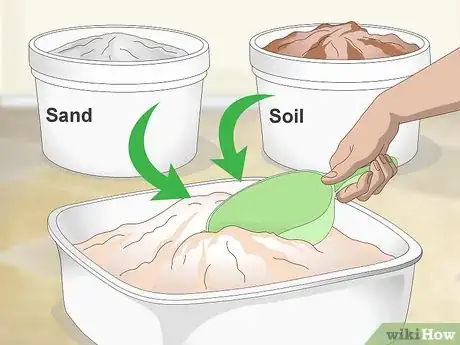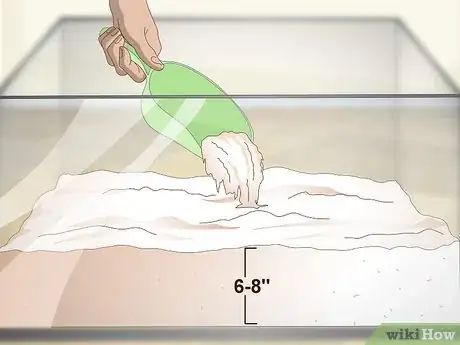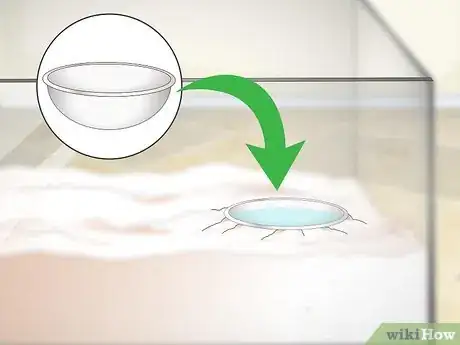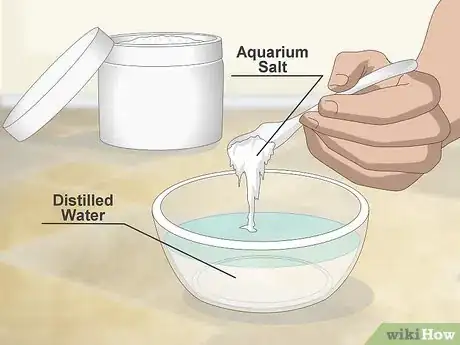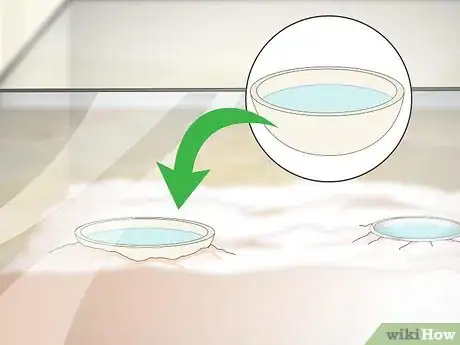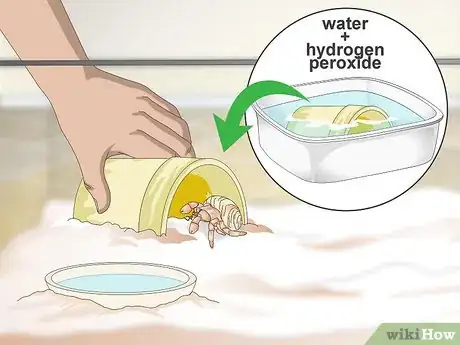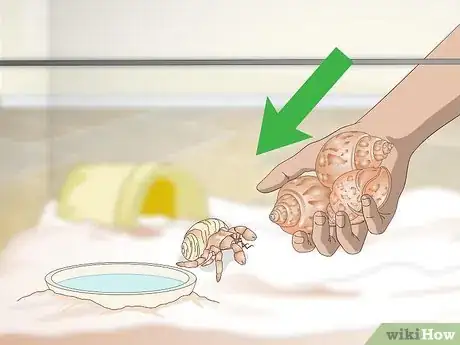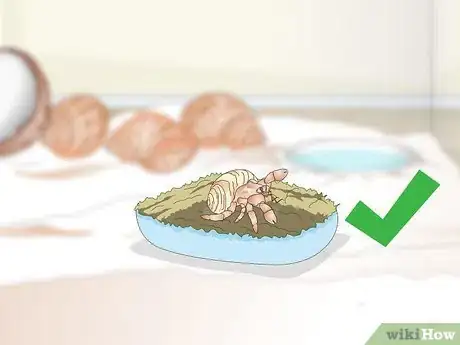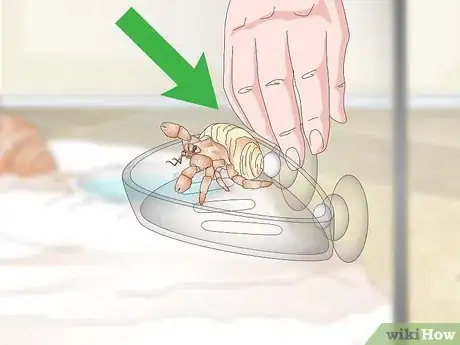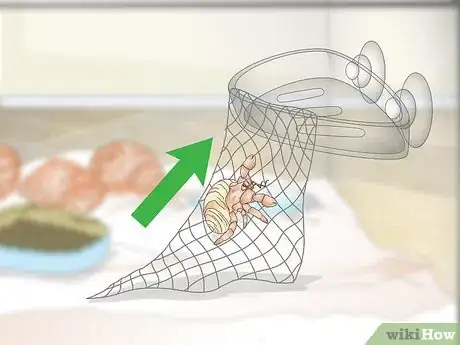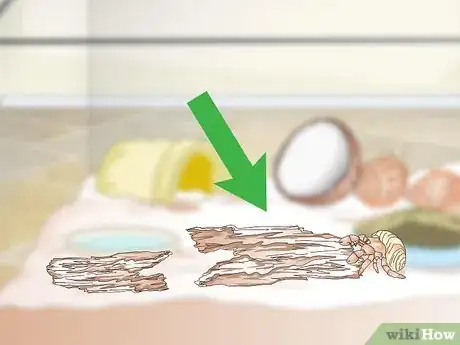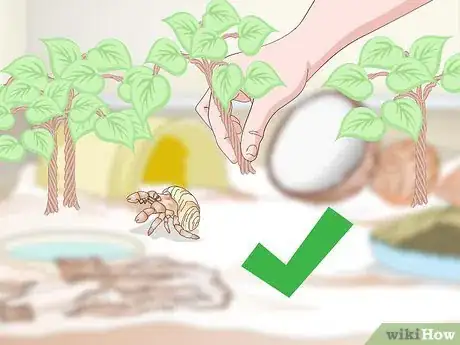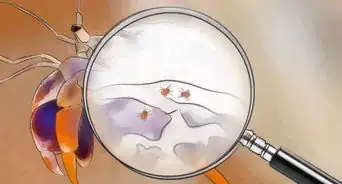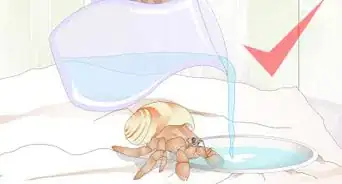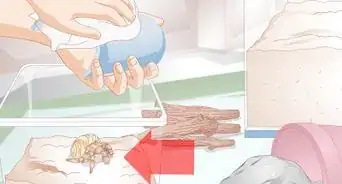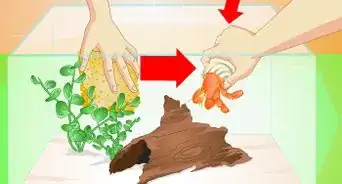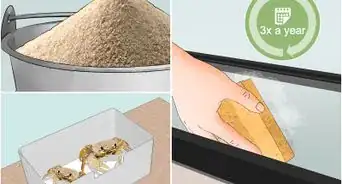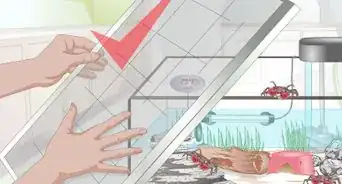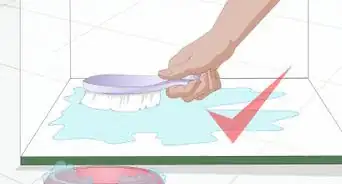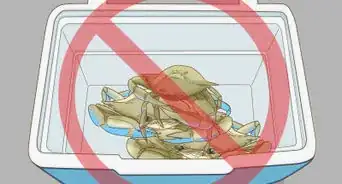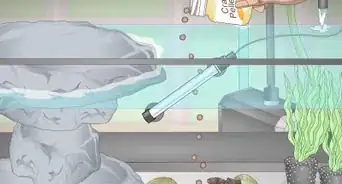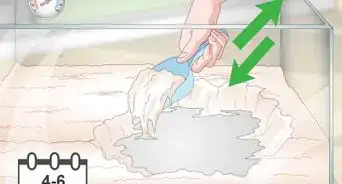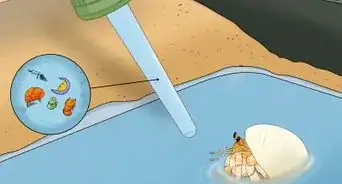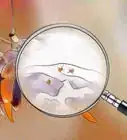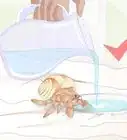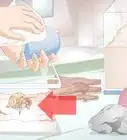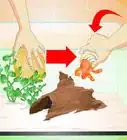This article was co-authored by Marshall Stephens. Marshall Stephens is an Aquarium Expert at Private Oceans Aquariums in West Palm Beach, Florida. Marshall has over 20 years of experience in the aquarium industry and focuses on captive-bred animals. They specialize in tropical and marine aquariums and are a contributor to the Loggerhead Marine life center in Jupiter Florida.
There are 7 references cited in this article, which can be found at the bottom of the page.
This article has been viewed 81,981 times.
You should favor functionality over style as you decorate a unique “crabitat” for your hermit crab. Since hermit crabs love to climb, you’ll need to think about the climbing structures, such as driftwood, fake plants, and fishnets. To allow your crab to move homes, put in a few extra shells. Hiding places can be made from pots, coconut shells, and moss. A relaxing shoreline for drinking and bathing is also important to consider.
Steps
Making a Shoreline
-
1Choose a substrate material. Since hermit crabs molt underground, you’ll need to offer them a suitable substrate. In nature, they tend to prefer substrates that are very moist, with a mixture of coarse sand and soil. You can recreate this experience for your hermit crab by mixing a coarse sand with some coconut fiber. You can also use one of the following substrates:[1]
- Pre-mixed, hermit crab substrate.
- An all purpose, pet safe sand from your local hardware store. However, you should double check to make sure it is pet safe, which should be listed on the label.
- As a last resort, you can use play sand. Since it doesn’t hold moisture well and may contain antibacterial or fungal agents, you should only use it as a last resort.
- If your backyard soil hasn’t been exposed to contaminants or pesticides, you can go ahead and use it.
-
2Add enough substrate for your hermit crab. You’ll need to add the right depth of substrate for the size of your hermit crab, such as six inches of sand for a very small crab. After adding the substrate, you should moisten it with a watering can. The sand mixture should be about as moist as the sand you would use to build a sand castle.[2]
- If your hermit crab is 1’’ or less, you can add six inches of substrate.
- if your hermit crab is 1 5/8’’, you can add between 6’’ and 8’’ of substrate.
- Add between 8’’ and 10’’ for a 2 ½’’ hermit crab.
- Add 12’’ or more for a jumbo 3’’ hermit crab.
Advertisement -
3Install a shallow freshwater container. Place a container with spring water or dechlorinated water in the tank. To create the illusion of a lake or stream shoreline, you should place the dish in a low area of the tank. Place the container so that your crab can get in and out easily.[3]
- Since your hermit crab will be drinking the water, you want to make sure it is dechlorinated and free of contaminants.[4]
- You can get ceramic or decorative water dishes at your local pet store. Make sure they are large enough to fit your hermit crab, since they like to hang out inside the dishes.
-
4Mix distilled water with aquarium salt. Since tap water contains chlorine and well water has too many minerals, it is best to start with distilled water. Add the recommended amount of aquarium salt to the distilled water. The specific amount should be listed on the package of aquarium salt.[5]
- If you are dechlorinating tap water, you can add ten dechlorination drops to a gallon of tapwater.[6]
-
5Add a saltwater container. Fill a water container with the saltwater mix. Place the saltwater container in another low area of the tank, so that it looks like an ocean beach.[7]
- If you have one low area in the tank, you can place the saltwater container near the freshwater container.
Creating Hiding Places
-
1Add a broken ceramic pot. Your hermit crab will need lots of places to hide. One of these hiding spots could be a broken ceramic pot, which you could pick up from a garden center or a pet store.[8]
- You should disinfect it first with a mixture of two parts dechlorinated water and one part hydrogen peroxide.[9]
- Since hermit crabs are scavengers, they may hide food between little cracks in your decorations. Be aware that this can cause mold. Sweep through the substrate every few days to check for buried food.
-
2Place some sanitized shells on the substrate. To allow your hermit crab to move to a new shell, you should add three large shells. Hermit crabs love housing options. Each shell should be a bit larger than the crab’s current shell.[10]
-
3Make coconut caves. Start by opening up a coconut. Put a screwdriver on the indentation of the coconut. Using a hammer, bang the screwdriver into the coconut and pry it open so that you have two halves. Use a spoon to take out the meat, which you can feed to your crabs. Leave it in dechlorinated saltwater for twenty-four hours, and then dry it out in the oven. Place the two halves of the coconut in your tank.[11]
- For dehydration, you can bake it at 200 Fahrenheit (93 Celsius) for 30 minutes.
-
4Lay down a moss pit. Pick up some moss from the pet store. Sprinkle it across the substrate. Put a bunch into a plastic shower container to create a little moss pit.[12]
- If you prefer, you could also add a little bit of substrate to the bottom of the container. Then, fill it up with some moss for a little play area.
- Don’t use craft moss or any dyed mosses.
-
5Install a shower container with suction cups. You can get some shower containers, such as the kind used to store soap in a shower. If the container doesn’t come with suction cups, you can pick some up from the dollar store. Install the shower container on the side of the tank for a higher hiding place.[13]
Building a Climbing Gym
-
1Build decorative fish net climbing structures. You can make a climbing wall with decorative fish net. You can also make a little canopy, or a little bridge to connect one part of the tank to another. If you have a shower container in your tank, you could use the fish net to make it accessible.[14]
- Fish netting can be purchased from an arts and crafts store.
- Boil the fish net before installing it. You want to make sure it is disinfected before putting it in the tank.
-
2Place some driftwood around the tank. If you are going on vacation soon, remember to bring back some driftwood! If not, you can always order driftwood online. You can make driftwood arrangements by connecting the pieces of driftwood together with plastic zip ties.[15]
- Half logs also look great.[16]
- To disinfect the driftwood, you should soak it in saltwater overnight. Then, bake it at 200 Fahrenheit (93 Celsius) for 30 minutes.
-
3Put in fake plants for a beautiful crabitat. The fake plants designed for reptiles or fish tanks work really well. Pick up some vines, grasses, and ferns. Arrange them around your tank to create a beautiful crabitat.[17]
- You can get nice fake plants at your local pet store or even at the dollar store.
Community Q&A
-
QuestionCan I use fake plants for my crabs?
 Community AnswerYes! You can use a variety of different decoration,s as long as they don't have toxic paint on them.
Community AnswerYes! You can use a variety of different decoration,s as long as they don't have toxic paint on them. -
QuestionShould I keep other shells in my tank?
 Community AnswerYes, as a hermit crab like to change shells.
Community AnswerYes, as a hermit crab like to change shells. -
QuestionWhat kind of foods are safe for them, and how many times a day should I feed them?
 Daphne LameschCommunity AnswerCheck their food at least once a day. Change it if it has mold, or if there is too little. You should have pellets and calcium sand available for them at all times. Some good treats are: grapes, raisins, Cheerios (regular kind), Goldfish (regular kind, no salt), coconut, strawberries.
Daphne LameschCommunity AnswerCheck their food at least once a day. Change it if it has mold, or if there is too little. You should have pellets and calcium sand available for them at all times. Some good treats are: grapes, raisins, Cheerios (regular kind), Goldfish (regular kind, no salt), coconut, strawberries.
Warnings
- Make sure you don't decorate the tank so much that there's no room for the crabs themselves. They're the stars. Not that 4" by 4" coral that dominates the whole tank.⧼thumbs_response⧽
- Do not provide your crabs with painted shells. The paint may chip and is toxic for your crab. Also, paint on the inside of shells may cause the crabs to become "trapped," since it may melt.⧼thumbs_response⧽
Things You'll Need
- At a least a 10 gallon (37.9 L) aquarium. This will depend on how many crabs you intend to keep and the size you intend to buy.
- A heating source
- Thermometer and Hygrometer to measure temperature and relative humidity.
- Play sand, Hermit crab sand, marine sand or Eco-Earth (coconut fiber) or a mix of sand and coconut fiber.
- Non-metal food, saltwater and freshwater containers.
Expert Interview
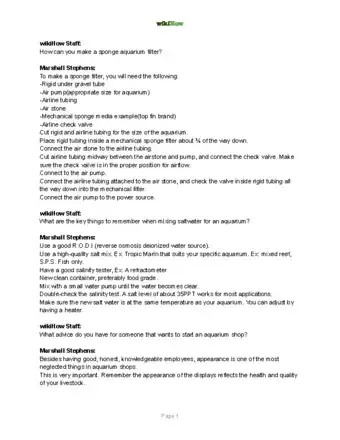
Thanks for reading our article! If you'd like to learn more about aquariums, check out our in-depth interview with Marshall Stephens.
References
- ↑ http://www.hermitcrabpatch.com/Hermit-Crab-Key-To-Survival-Deep-Moist-Substrate-a/133.htm
- ↑ http://www.hermitcrabpatch.com/Hermit-Crab-Key-To-Survival-Deep-Moist-Substrate-a/133.htm
- ↑ http://www.drsfostersmith.com/pic/article.cfm?articleid=2386
- ↑ https://www.hermit-crabs.com/care.html
- ↑ http://www.hermitcrabpatch.com/Hermit-Crab-Key-To-Survival-Freshwater-And-Saltwater-a/140.htm
- ↑ http://animals.mom.me/dechlorinate-water-hermit-crabs-1504.html
- ↑ http://www.drsfostersmith.com/pic/article.cfm?articleid=2386
- ↑ http://www.drsfostersmith.com/pic/article.cfm?articleid=2386
- ↑ http://happyhermitcare.tumblr.com/Hermitcrabdeorationguide
- ↑ http://www.drsfostersmith.com/pic/article.cfm?articleid=2386
- ↑ http://happyhermitcare.tumblr.com/Hermitcrabdeorationguide
- ↑ http://happyhermitcare.tumblr.com/Hermitcrabdeorationguide
- ↑ http://happyhermitcare.tumblr.com/Hermitcrabdeorationguide
- ↑ http://happyhermitcare.tumblr.com/Hermitcrabdeorationguide
- ↑ http://happyhermitcare.tumblr.com/Hermitcrabdeorationguide
- ↑ https://pethermitcrabs.org/cage-habitat/
- ↑ http://happyhermitcare.tumblr.com/Hermitcrabdeorationguide
